VISUALIZATION OF GREENHOUSE ENVIRONMENT BY VRML
Tsuyoshi Honjo, Naohiro Kohira and En-Mi Lim
Graduate School of Science and Technology, Chiba University
Abstract: In this study, we developed a greenhouse visualization system by using VRML (Virtual Reality Modeling Language) that is a high performance language for 3-D visualization on WWW (World Wide Web). We developed a converter from designed parameters of a greenhouse to VRML format. Plant grown in a greenhouse can be chosen as one of parameters. Plant was visualized with 2 textured planes. We also made a database of two-dimensional plant images of several growth stages from 3-D plant shape generated by AMAP (a plant modeling system that produces very precise 3-D plant shape). With the developed system, greenhouses were visualized for the validation of the system. By using the system, walk thorough simulation in the greenhouses was possible in spite of the huge number of plant and building data. In conclusion, the system developed in this study can produce a very high quality images and will be used for design and visualization of greenhouses with very low cost.
Keywords: Computer graphics, greenhouse, virtual Reality, visualization, VRML
1. INTRODUCTION
In a design of greenhouse, walk through simulation in a 3-D space is a powerful tool, especially for the understanding of the design and for selection of alternative design. In the walk through simulation, reality of the simulated image is very important and recent progress of computer graphics (CG) enables very precise simulation.
In the CG of greenhouse, plants in the greenhouse also play an important role. Many researchers have studied realistic plant modeling (Honda, 1971; Aono and Kunii, 1984; Bloomenthal, 1985; Oppenheimer, 1986; Prusinkiewicz, 1988; De Reffye et al, 1988; Greene, 1989; Viennot et al., 1989). By using techniques of plant modeling, very realistic images of plants have been made. We utilized this technique.
In this study, we developed a greenhouse visualization system by using VRML (Virtual Reality Modeling Language). The VRML system enables real time virtual experience of gwalk through simulationh in a designed greenhouse. VRML is also a high performance language for 3-D visualization on WWW and 3-D information that can be easily transferred through Internet (Honjo et al, 1997; Honjo and Takeuchi, 1998).
Application of virtual reality needs real time rendering of the landscape according to the moving viewpoint. Formerly, to realize the real time rendering, expensive virtual reality system consisted of input and output devices and high-performance computer. On the other hand, to make virtual reality environment on the Internet with VRML, it is possible to make the environment on personal computer economically.
2. METHOD
2.1 VRML
In the design of greenhouse, feed back process shown in Fig. 1 is important between designer and users. The VRML system is suitable for this feed back process because walk through simulation on the Internet contributes the understanding of the user (Honjo et al. 1999).
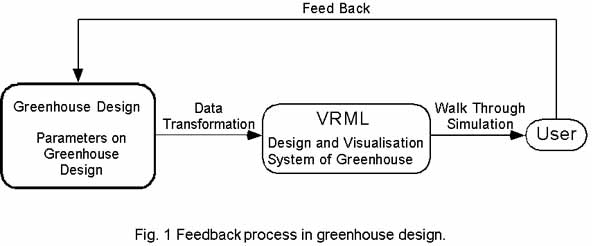
VRML is a programming language or library for three dimensional computer graphics and has many functions. In this study VRML 2.0 was used to make the system.
To make the rendering very fast, VRML supports only simple rendering technique such as shading ,setting objects, projection, and texture mapping but does not supports complicated rendering such as ray tracing. Programming by VRML is easier than that by graphic library like OpenGL.
The user who downloads the program from a server can use a program made by VRML. A 3-D image made by VRML is rendered on the computer of the user. To use the VRML, browser that supports VRML is necessary. In this study, Cosmo Player (Silicon Graphics Inc.) with Internet Explorer (Microsoft) was used as VRML browser.
As a developing environment of VRML programming, the VRML browser and Internet browser are necessary. Programming and landscape planning is possible on a stand-alone computer. Cosmo Player and other VRML browser can be used as a freeware and we can build the developing environment very economically.
Many CAD (Computer Aided Design) systems have a function of conversion to VRML format. Data made for other system can be converted and be used again.
2.2 VRML and Design of Greenhouse
As a basic function for the design of greenhouse, modeling and setting of plants, and architecture is necessary. The procedures of the visualization are shown in Fig 2.
To validate the planning, many perspective images should be made and discussed. By using the VRML system, once the program of the greenhouse is made, changing the viewpoint is easy and walk through simulation is possible.
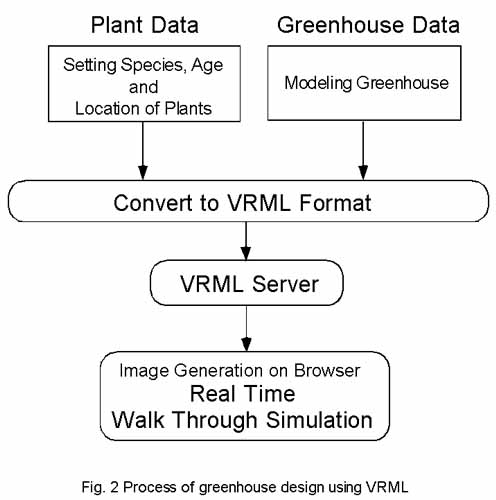
2.3 Modeling of Plants
As a texture, we mainly used CG images of plants made by AMAP (Atelier de Modelisation de Architecture de Plants), which is the system (developed by CIRAD, Center Internationale Recherche Agricultural Development) that produces high precision 3-D plant shape. AMAP is one of the outputs of the study of plant by DE Reffye et al.(1988). AMAP generates botanically realistic 3-D computer graphics. By AMAP 3-D CG images of several growth stages can be easily made and they are used as a texture.
3-D Plants made by CG by AMAP consist of some thousands to some million polygons. Such a polygon model needs tremendous time for the rendering. Therefore, we use only 2-D image textures made from 3-D model images in this study and 2-D plant image database was developed. Plant images were converted to transparent GIF format. Plant was visualized with 2 textured planes. Examples of plant image in the database are shown in Fig. 3.
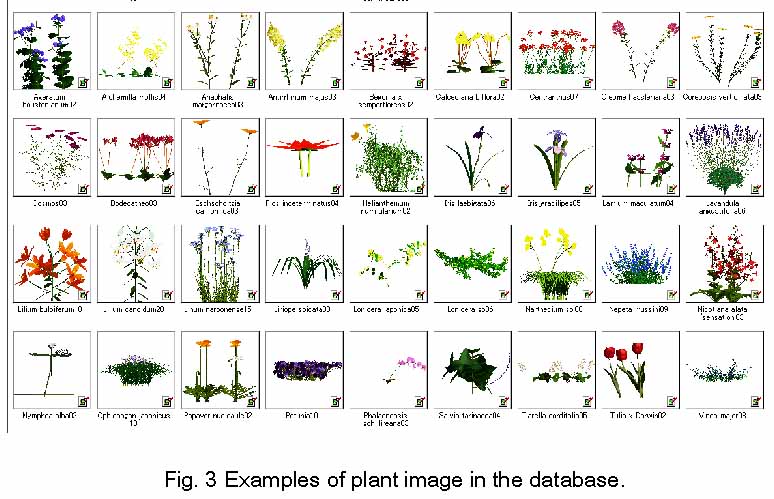
2.4 Modeling of Architecture and Conversion to VRML
To make architecture of greenhouses simple objects were used. There were a lot of parameters that user can change. Parameters that user can change are shown in the menu in Fig. 4.
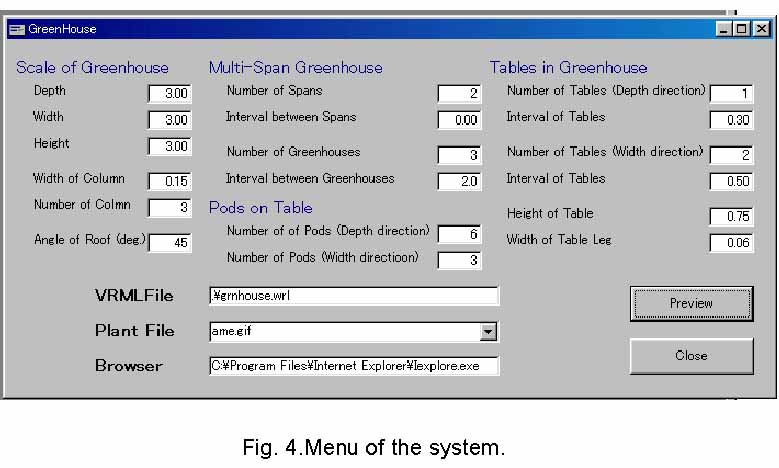
We converted from the parameters of the greenhouse to VRML format. For the conversion, program was developed in this study by Visual Basic (Microsoft Inc.).
3. RESULT
3.1 Visualization of Greenhouses by VRML
By using the developed greenhouse design system, VRML program was made and the performance of the system was shown. Examples of images of greenhouses are shown in Fig. 5.
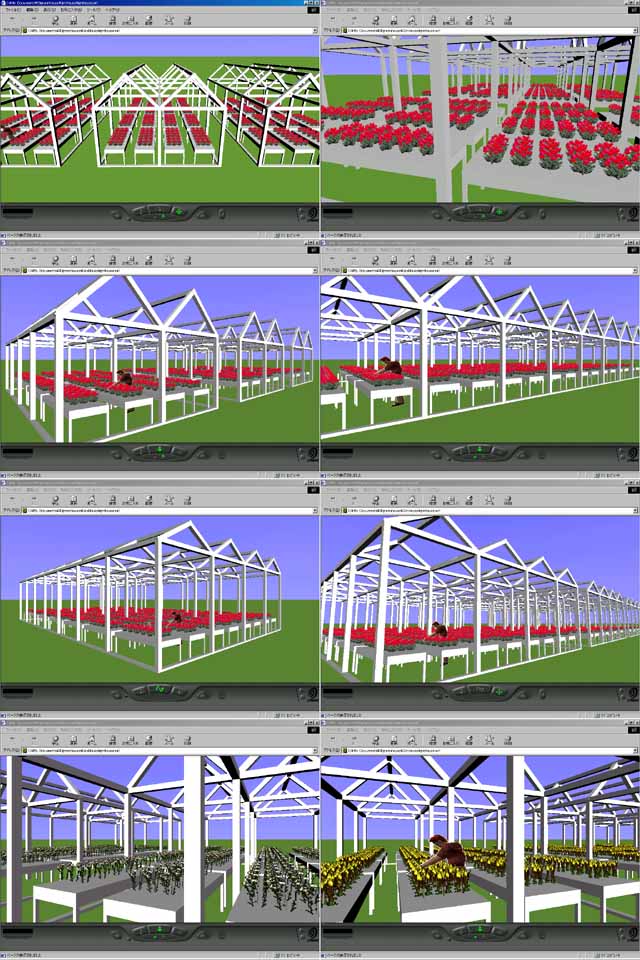
Walk through simulation was very smooth with this data (with computer of Cerelon 300MHz CPU).
With the system developed in this study, we proved that greenhouse using VRML was possible and indicated that the system can be used as a practical and low cost design system.
3.2 Communication on WWW
The VRML programs made in this study were placed on WWW server. Apache was used as WWW server program. In the design of greenhouses, using WWW to transfer information to the user is considered as very important and practical method.
4. DISCUSSIONS
4.1 On Amount of Data
When we consider the access to the VRML file, the data should be within the size of smooth transfer on the network. Most of the VRML file of the simulated greenhouse was less than 1 MB. For the users, this size of VRML enables smooth data transfer on the net and walk through simulation.
Original quality of the plant images was very high. To reduce the file size, resolution of used with VRML files were compressed and the quality of the images also degraded according to the degree of compression. Optimal degree of compression should be decided by trial and error with considering file size.
4.2 Possibility of Virtual Greenhouse Design
In this study, we developed the system that visualizes greenhouses in 3-D and the system can also be use for the future prediction of the greenhouses.
Visualization of environmental information by digital contents on WWW is powerful tool for providing the information economically. We can develop the visualization method of virtual greenhouses by using VRML and link digital contents such as simulated environmental data and product information. The methods are useful tools for showing environmental information.
5. CONCLUSIONS
In this study, VRML was used for greenhouse design system and its availability and possibility were shown. Database of plant images with various species and growth stages were also developed. With the system, greenhouse models were made and walk thorough simulation was also possible. The 3-D information can be easily transferred through Internet by this technology.
The system showed good performance and it also indicated the potential of building virtual reality system by VRML with very low costs.
REFERENCES
Aono, M. and Kunii, T., 1984. Botanical Tree Image Generation. IEEE Computer Graphics & Applications, 4, 10-34.
Bloomenthal, J., 1985. Modeling the Mighty Maple. Computer Graphics, 19, 305-311.
De Reffye, P. et al., 1988. Plant Models Faithful to Botanical Structure and Development. Computer Graphics, 22, 151-158.
Greene, N., 1989. Voxel Space Automata:Modeling with Stochastic Growth Processes in Voxel Space, Computer Graphics, 23, 175-184
Honda, H., 1971. Description of the Form of Trees by the Parameters of the Tree-like Body:Effects of the Branching Angle and the Branch Length on Shape of the Tree-like Body. J. Theor. Biol., 31, 331-338.
Honjo, T., Hoshi, T. Takeuchi, S. and Fuse, J., 1997. Visualization System of Environmental Information on Internet. Journal of the Japanese Institute of Landscape Architecture, 60(5), 611-614. (In Japanese with English summary)
Honjo, T. and Takeuchi, S., 1998. Method for Three Dimensional Terrain Visualization on Internet. Journal of the Japanese Institute of Landscape Architecture, 61(5), 605-608. (In Japanese with English summary)
Honjo, T., Lim, E. and Maruta Y., 1999. Landscape Visualization by VRML. Journal of the Japanese Institute of Landscape Architecture, 62(5), 665-668. (In Japanese with English summary)
Oppenheimer, P. E., 1986. Real Time Design and Animation of Fractal Plants and Trees. Computer Graphics, 20, 55-64.
Prusinkiewicz, P. et al., 1988. Developmental Models of Herbaceous Plants for Computer Imagery Purposes. Computer Graphics, 22, 146-160.
Reeves, W. T. and Blau R., 1985. Approximate Probabilistic Algorithms for Shading and Rendering Structured Particle Systems. Computer Graphics, 19, 313-322.
Viennot, X. G. et al., 1989. Combinatorial Analysis of Ramified Patterns and Computer Imageryof Trees. Computer Graphics, 23, 31-40.





